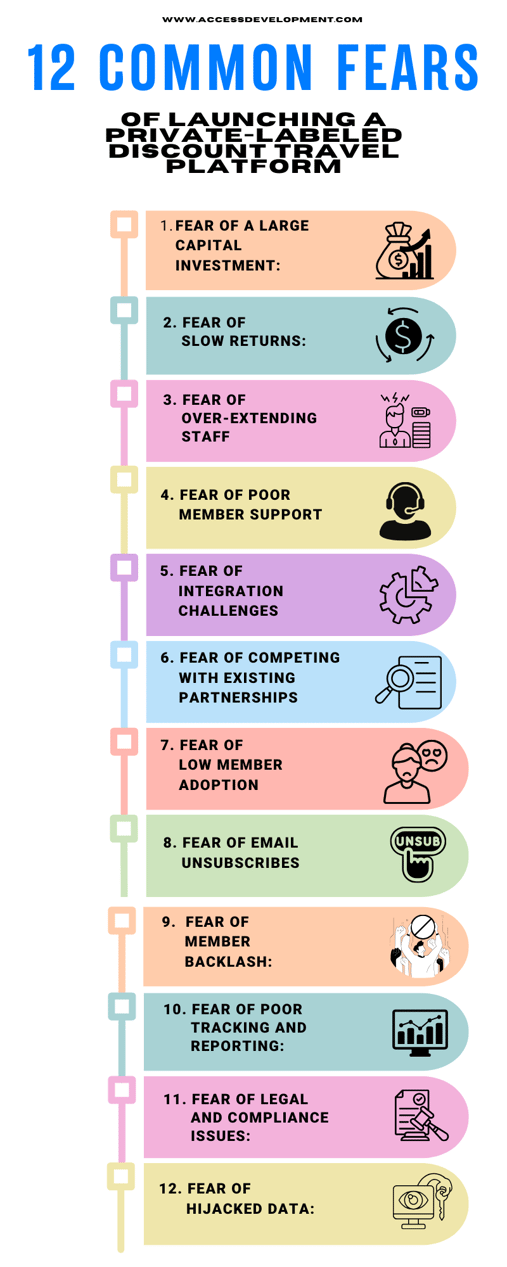A Cure for the Non-Dues Revenue Blues
Tackling 12 common fears about launching a non-dues revenue program
Summary: Launching any new non-dues revenue program comes with a certain amount of risk. Yet some associations are unnecessarily paralyzed by a few unfounded, yet common fears and concerns. Here are answers to 12 common fears many associations have when considering a non-dues revenue program, using a private-labeled, discount travel platform as an example.
About a 7-minute read
If your organization is like many I’ve encountered lately, generating non-dues revenue has become a big concern.
Finding a powerful revenue-generating (rev-gen) program, likewise is also not as easy as it used to be.
Non-dues revenue is essential for most associations, as it usually supports staff salaries, operational expenses, and program development. A decline in this important source of revenue can have lasting consequences on organizations, leading to a reduction in popular educational and networking programs, or causing painful budget deficits and even layoffs. More and more, the ability of any association to succeed depends greatly on having a diversified revenue stream.
With these and other looming challenges, the need to innovate and experiment with new revenue streams has become more than a strategic move – it's a necessity for survival and growth. Many otherwise successful organizations are now urgently seeking creative solutions to augment or replace their dwindling income, but they’re also seeking to add programs that will simultaneously enhance their association’s overall value proposition.
Why is it so hard?
If you’re wondering how to generate more revenue, you’re not alone. This 2023 study reports that for most associations, “generating non-dues revenue (is) their greatest challenge.”
Why has it become such a challenge?
You could blame the lagging economy, advances in technology, competition, inflation, workforce shortages, or a combination of all the above. The fact is many associations are grappling with the challenges of finding new, reliable streams of revenue.
To complicate matters, we’ve also seen a trend where about half of all membership organizations are seeing their member numbers either drop or flatline. The reasons for this drop are far too complex to discuss adequately here in this article, but collectively it’s impacting many associations’ revenue in a big way.
For our purposes here, I’m not going to talk about some of the more common, labor-intensive revenue sources, like events (i.e. a 5K, banquets, big gatherings, etc.), conferences/sponsorships, merchandise, fundraising, etc.
Having spent over two decades immersed in the world of member-based associations and organizations, I must confess my inclination towards a white-labeled discount travel platform as a prime example of a successful rev-gen program. While I use these travel platforms as a reference point, these principles can undoubtedly be applied to a variety of revenue-generating programs.
If you’re not familiar with a discounted travel platform, think of it as a plug-and-play online travel booking engine that allows you to offer wholesale rates on hotels and other discounted travel benefits to your members, while also generating transaction-based back-end revenue.
What’s so special about this type of rev-gen program?
- It doesn’t have to be a burden on your staff.
- It won’t cost much (if anything) to implement.
- It can help you attract new members, and better engage existing members.
- It’s almost completely managed by your vendor.
Why offer a travel platform to your members?
With the pandemic in the rearview mirror, more and more people are itching to travel, as 92% of Americans expect to travel more this year than last; and a record number of Americans are now planning overseas travel. Another study shows that 84% of American workers are excited about planning their next vacation, and 97% say the mere process of planning a trip makes them happier. Maybe it’s no surprise that the average American takes three vacations per year, with the average family of four spending $3,609 on a 3-day vacation.
If you want to offer a benefit that’s relevant to your members, a compelling travel benefit can have broad appeal.
Once you’ve settled on a travel rev-gen program, it then comes down to tackling the most common issues and concerns most organizations have with setting up and launching such a program.
In all candor, I’ve encountered many organizations that are good at talking the talk about their commitment to improving their value-added benefits, and especially about the need to add value AND generate non-dues revenue. Yet, when it comes right down to actually launching any type of less conventional rev-gen program, they just can’t seem to pull the trigger.
Many of these leaders may offer a multitude of explanations for why they ultimately decided against launching a new program they were enthusiastic about, but in the end, the harsh reality was that they couldn't overcome their fears.
Fear of failure.
Fear of criticism
Fear of change.
Even a fear of success.
Most organizations, (including for-profit organizations…I’m not just singling out associations), have many of the same fears and concerns about launching a new program. The key to successfully launching any non-dues rev-gen program lies in identifying, understanding, and then mitigating the most common risks and fears.
Here are 12 of the most common fears and concerns organizations/associations face when they consider a travel-related rev-gen program:

- Fear of a Large Capital Investment: Nearly all the white-labeled discount travel platforms require minimal out-of-pocket investment. Such vendors are more than willing to shoulder most of the initial costs relating to setting up your program. They may, however, require that you cover some of the hard costs associated with setting up and launching your specific program, but it’s usually not more than $4-5K and is often negotiable.
- Fear of Slow Returns: When launching a new program, it can be difficult to predict the revenue it will generate, especially when there are so many unknown variables. These variables include the size and quality of your list and any limits you place on promoting the program. Then there are the variables of your vendor. Can they deliver compelling savings to keep your members coming back? What’s the quality of their technology and their promotional deliverables? When all these aspects align successfully, it leads to a program that can thrive over time. So, what does success look like? When should you expect to generate enough revenue to make it all worth it? It’s hard to predict, but I would point to a rule of thumb for a typical start-up business. They can expect to reach profitability in two to three While it may take a year or two to reach significant levels of revenue for your association, that doesn’t mean your program is doing poorly. It just means you’re building a sustainable program that can grow over time.
- Fear of Over-Extending Staff: Launching any new program requires some investment in your staff’s bandwidth. The fear, however, is creating a long-term burden that negatively impacts your core mission. This study found 55% of associations/organizations report being understaffed. In my experience, that seems like a low number. Which is why it’s no wonder some associations fear launching new revenue-generating programs out of concerns about putting a strain on their organization’s operations. Addressing staffing needs becomes crucial when planning for the successful launch and management of any new revenue-generating initiatives. But that’s why you hire the right vendor. It’s their job to administer the day-to-day minutia of their program, shouldering most of the promotional workload, and leaving your team to do what they do best. Usually, your staff should only be bothered with setting KPIs and making occasional annual adjustments to strategy. Speaking from experience, once a good travel discount platform is launched, it doesn’t need much oversight or babysitting.
 Fear of Poor Member Support: Many organizations worry about how their rev-gen program will be supported when a member has a question or issue while using the program. Not only is it a concern about the impact on staff resources, but it’s also a matter of having access to data, booking details, or other transactional information specific to each member. While I know other rev-gen programs offer customer service, some may charge your members a fee for contacting them. Others only offer an online FAQ or email-only member support. That’s no bueno, especially if a member is having an issue checking into a hotel at midnight. Look for a vendor that provides free, live, human interaction 24/7/365 for all travel-related transactions. Each call should be answered as if it were your organization, so your brand is reinforced, not your vendor’s. They shouldn’t charge your members anything to talk to a live person. This high level of member support is critical to the success of your travel program.
Fear of Poor Member Support: Many organizations worry about how their rev-gen program will be supported when a member has a question or issue while using the program. Not only is it a concern about the impact on staff resources, but it’s also a matter of having access to data, booking details, or other transactional information specific to each member. While I know other rev-gen programs offer customer service, some may charge your members a fee for contacting them. Others only offer an online FAQ or email-only member support. That’s no bueno, especially if a member is having an issue checking into a hotel at midnight. Look for a vendor that provides free, live, human interaction 24/7/365 for all travel-related transactions. Each call should be answered as if it were your organization, so your brand is reinforced, not your vendor’s. They shouldn’t charge your members anything to talk to a live person. This high level of member support is critical to the success of your travel program.- Fear of Integration Challenges: Integrating any new program with your existing digital platform will always seem a bit daunting. Many organizations, rightly so, are fearful of scope creep, where the integration process drags on and then threatens their existing programs. While I can’t speak for all the other types of transaction-based rev-gen programs out there, for the most experienced programs, the typical time between signing the contract and launching a new program is only a few weeks, not months or longer. However, some very large organizations with significant IT resources may want to customize the user experience of their discount platform. This may take additional time to digest an API or tackle other more complex integration challenges. However, most organizations/associations will simply frame-in a website into their existing platform and be up and running within a few weeks.
- Fear of Competing with Existing Partnerships: Organizations might fear that launching a travel discount program could conflict with their existing partnerships or sponsorships, potentially losing out on important revenue. For example, your organization already has a deal with Avis Car Rental, and you don’t want to lose that relationship and revenue. It’s a legitimate concern, but in most cases, your vendor can seamlessly integrate your organization’s existing discount relationships into your new platform. You can continue to generate revenue from those existing relationships, and you may likely enjoy greater revenue once members have a simple, unified interface on your discount website and mobile platform.
- Fear of Low Member Adoption: Most organizations have concerns about whether or not their members will actually use the program, thus leading to wasted time, resources, and goodwill. Member usage will largely depend on your organization’s willingness to allow your vendor to promote your program. I’m not talking about giving the vendor carte blanche to send as many emails as they wish, but I am suggesting you come to an agreement that sending frequent, meaningful emails is critical to your program’s success. This large education association likewise had those same fears, yet they agreed to leverage the vendor’s promotional assets to drive member registrations and travel bookings. The result was double-digit growth in registrations and bookings in the first year. Any successful rev-gen partner should have a strategy to help their clients drive ongoing usage, and they should be willing to foot the costs of executing that strategy. Your program’s success will depend largely on sending consistent, relevant emails to your members. This leads us to the next concern.
-
 Fear of Email Opt-outs: As stated above, launching any type of new rev-gen program will require a comprehensive campaign to communicate the value of that new program to your members. Yet, many organizations I’ve encountered are paralyzed by a fear that their unsubscribe rate will shoot through the roof. My experience is that the unsubscribe rates don’t necessarily rise much at all. And when a member unsubscribes from the travel-related emails, they remain subscribed to all the other emails you send from your organization. Many programs experience a declining unsubscribe rate because members are getting emails that are adding compelling value. It all comes down to relevance. If the email delivers a powerful and relevant message to each member, they’ll welcome it in their inbox. But let’s face it…with any email, there’s an unavoidable number of opt-outs. It’s just the unfortunate reality of sending any email campaign. But people unsubscribe for a host of reasons, and it's not always dissatisfaction with the subject matter of your email. They may receive multiple emails from you. They may want to use a new email instead of the one you send to. Maybe they’re unsubscribing because a spouse is getting your email too. If after a while you’re still concerned about the number of unsubscribes, a good vendor should be happy to adjust their email cadence and content to address any issues you have with unsubscribes.
Fear of Email Opt-outs: As stated above, launching any type of new rev-gen program will require a comprehensive campaign to communicate the value of that new program to your members. Yet, many organizations I’ve encountered are paralyzed by a fear that their unsubscribe rate will shoot through the roof. My experience is that the unsubscribe rates don’t necessarily rise much at all. And when a member unsubscribes from the travel-related emails, they remain subscribed to all the other emails you send from your organization. Many programs experience a declining unsubscribe rate because members are getting emails that are adding compelling value. It all comes down to relevance. If the email delivers a powerful and relevant message to each member, they’ll welcome it in their inbox. But let’s face it…with any email, there’s an unavoidable number of opt-outs. It’s just the unfortunate reality of sending any email campaign. But people unsubscribe for a host of reasons, and it's not always dissatisfaction with the subject matter of your email. They may receive multiple emails from you. They may want to use a new email instead of the one you send to. Maybe they’re unsubscribing because a spouse is getting your email too. If after a while you’re still concerned about the number of unsubscribes, a good vendor should be happy to adjust their email cadence and content to address any issues you have with unsubscribes. - Fear of Member Backlash: Some leaders may worry that members will perceive the new program as unsavory or is somehow a deviation from the organization's core mission. Most successful organizations already do a good job of messaging the need for the organization to grow, and why offering greater value will enhance their existing member benefits. While it’s impossible to prevent some members from complaining, once most members see the relevant value of your new program, you’ll likely experience few issues otherwise.
- Fear of Poor Tracking and Reporting: Having accurate financial and usage reports is critical to any rev-gen program’s ongoing success. Your organization should demand transparency from your vendor, not only as it relates to usage, but especially with the revenue your members generate. Any reputable rev-gen program will eagerly share important information to demonstrate the accuracy of how they track and report usage, along with all revenue generated by your program. Be wary of any program that does not provide regular, consistent usage and financial reports.
- Fear of Legal and Compliance Issues: Some worry about compliance with various regulations, such as data privacy or consumer protection laws. This may be especially concerning when your rev-gen program offers consumer discounts. While each state may have its own unique laws governing consumer regulations, most established rev-gen programs already comply with each state’s consumer protection laws, and you can check with reputable sources like the Better Business Bureau, your state’s consumer protection division, or a host of other watchdog sites. Your rev-gen partner should actively adapt to new laws in all jurisdictions, as it’s in their best interest to follow and comply with each state’s regulatory environment.
- Fear of Hijacked Data: The market for personal data is big business, and some engagement and loyalty companies use legalese and other complicated terms and conditions to gain access to your member data so they can pitch insurance and other products/services to your members. (Look for fancy words like “bulk enrollment,” it’s an underhanded way of saying they plan to use your data for marketing purposes.) It’s critical that you ask your vendor if they plan to make money by using or selling your member data. I’d also suggest that a great way to help prevent your data from being hijacked is to insist that your vendor is certified by SOC 2 (System and Organization Controls). SOC 2 was introduced by the CPA’s largest trade group (AICPA), to establish a reporting framework for data control systems. SOC 2-certified companies must meet a high standard of data security, availability, processing integrity, transparency, confidentiality, and privacy. In a nutshell, if your rev-gen program is SOC 2 certified, they’ve invested significant resources to give you confidence in their data security and privacy practices.
Is your association a good fit?
Most large organizations can be successful with a transaction-based rev-gen program, but some smaller associations may struggle. Much depends on the size and quality of your membership list, not to mention your tech stack and legacy infrastructure. Most rev-gen vendors will rely on automation for things like list maintenance and management. If your organization struggles with technology, you’ll likely be challenged with one of these programs. That’s not to say you can’t succeed, but you’ll simply find it more difficult to make it all work seamlessly. If you have concerns about any of these technical matters, the right vendor can assist you in identifying any issues that may be too difficult to overcome, or that otherwise may indicate your organization is not a good fit.
To sum things up…
Launching any new revenue-generating program comes with a certain amount of risk. However, a successful rev-gen program can have a transformative impact on organizations that are smart about understanding and mitigating the risks. While it’s only natural to have concerns and fears, your success lies in addressing each of your concerns directly and honestly.
What about you and your association? Have you had any experience with a transaction-based rev-gen program? What about a discounted travel platform? What are your experiences regarding this or similar transaction-based programs that can help generate non-dues revenue?
What questions or fears would you have? I welcome your comments and expertise. Share your thoughts or questions below and join the conversation.
Topics: Member Benefits, member retention, member acquisition, member engagement, membership benefits packages, association marketing, membership-organization, Membership Organizations, member loyalty, VALUE ADDED BENEFITS, membership benefits programs, Member Success, member engagement ideas, non-profit management, non-dues revenue
Written by: Gary Toyn
%20that%20simplifies%20the%20concept%20of%20travel%20bookings%20generating%20revenue%2c%20adhering%20to%20the%20previously%20s.webp?width=596&name=DALL%C2%B7E%202024-02-21%2016.08.21%20-%20Create%20a%20vibrant%2c%20wide-format%20illustration%20(2_1%20ratio)%20that%20simplifies%20the%20concept%20of%20travel%20bookings%20generating%20revenue%2c%20adhering%20to%20the%20previously%20s.webp)


.jpeg)







Share your Comment.